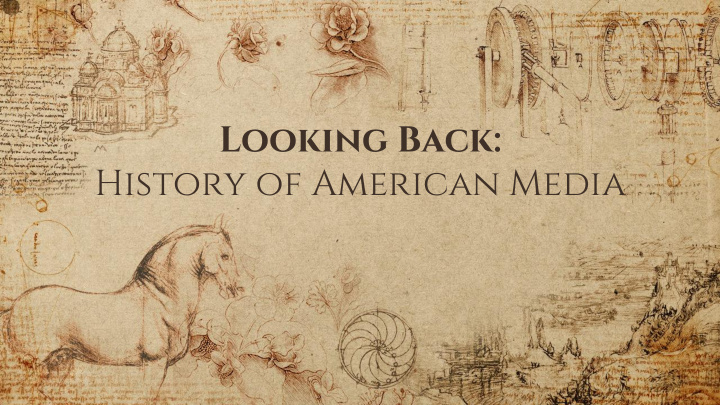



Looking Back: History of American Media
Learn these things Understand how printed press developed ✣ How the concept of freedom of press ✣ came into being Look at impact of radio, TV, and internet ✣ Recognize issues facing journalism today ✣
1. Printed whaaaat? Understand how printed press developed
timeline America's first newspaper, Publick Occurrences , is published in Boston. The paper, able to fill only three of its 1450-ish 1704 four pages with text, suspends publication after one issue after drawing criticism from the colonial government. The first successful American Johann Gutenberg invents newspaper, The Boston 1690 the printing press, printing his News-Letter is published. famous Bible. It was the first major book printed using mass-produced movable type.
timeline LIBEL: a published false statement that is damaging to a person's reputation; a written defamation. Freedom on the press is strengthened in the colonies when John Peter Zenger , jailed for libel 1729 1765 by a New York governor after printing harsh criticism, is acquitted. The Stamp Act forces all Ben Franklin takes over The papers to display an official 1735 Pennsylvania Gazette , British government seal and making it the boldest and pay a tax that raises prices 50 best paper in the colonies. percent. After violent protest, the act is repealed.
timeline The Pennsylvania Evening Post , a thrice-weekly, increases 1776 1791 its frequency to become America’s first daily newspaper. The Bill of Rights provides The Declaration of that “Congress shall make no 1783 Independence first law… abridging the freedom of appears publicly in The the speech or of the press.” Pennsylvania Evening Post and is reprinted in 20 other colonial newspapers.
timeline 1844 First practical 1876 typewriter patented. Alexander Graham Bell The telegraph is used invents the telephone ; within 1867 for the first time to 7 years telephone lines will transmit news, making connect New York and long-distance Chicago. reporting possible.
YELLOW JOURNALISM: a timeline sensational brand of journalism given to hoaxes, altered photographs, screaming headlines, frauds, and endless promotions of the newspapers themselves Yellow journalism reaches its heights as Hearst and Pulitzer 1880 1900 trump up war with Spain Satirical political First photograph is cartoons become a 1898 printed in a newspaper in popular way for the New York Daily newspapers to comment on Graphic. current events.
timeline Only 20,000 people owned televisions in 1945. By 1920 1963 now, 90% of American homes have a TV. TV news comes of age KDKA-Pittsburg begins covering the Kennedy 1960 broadcasting the first assassination ; 96% of regular radio schedule. homes with televisions watch an average of 32 hours of coverage.
timeline The Internet wires the planet. Laptop computers, digital cameras and modems allow reporters to file 1974 2007 stories and photos from anywhere in the world. The iPhone is the first smartphone President Nixon resigns model designed and marketed by 1990s following dogged Apple. This marks the beginning of investigation of the the public being able to receive news Watergate scandal by instantly at their fingertips. The Washington Post’s Woodward and Bernstein.
2. Amendments are important. I heard about them in history class. How the concept of freedom of press came into being
First Amendment Congress shall make no law respecting an establishment of religion, or prohibiting the free exercise thereof; or abridging the freedom of speech, or of the press; or the right of the people peaceably to assemble, and to petition the Government for a redress of grievances.
Freedom of speech includes the right: Not to speak (specifically, the right not to salute the flag). ✣ West Virginia Board of Education v. Barnette, 319 U.S. 624 (1943). Of students to wear black armbands to school to protest a war (“Students do not shed ✣ their constitutional rights at the schoolhouse gate.”). Tinker v. Des Moines, 393 U.S. 503 (1969). To use certain offensive words and phrases to convey political messages. ✣ Cohen v. California, 403 U.S. 15 (1971). To contribute money (under certain circumstances) to political campaigns. ✣ Buckley v. Valeo, 424 U.S. 1 (1976). To advertise commercial products and professional services (with some restrictions). ✣ Virginia Board of Pharmacy v. Virginia Consumer Council, 425 U.S. 748 (1976); Bates v. State Bar of Arizona, 433 U.S. 350 (1977). To engage in symbolic speech, (e.g., burning the flag in protest). ✣ Texas v. Johnson, 491 U.S. 397 (1989); United States v. Eichman, 496 U.S. 310 (1990).
Freedom of speech does not include the right: To incite actions that would harm others (e.g., “[S]hout[ing] ‘fire’ in a crowded ✣ theater.”). Schenck v. United States, 249 U.S. 47 (1919). To make or distribute obscene materials. ✣ Roth v. United States, 354 U.S. 476 (1957). To burn draft cards as an anti-war protest. ✣ United States v. O’Brien, 391 U.S. 367 (1968). To permit students to print articles in a school newspaper over the objections of the ✣ school administration. Hazelwood School District v. Kuhlmeier, 484 U.S. 260 (1988). Of students to make an obscene speech at a school-sponsored event. ✣ Bethel School District #43 v. Fraser, 478 U.S. 675 (1986). Of students to advocate illegal drug use at a school-sponsored event. ✣ Morse v. Frederick, __ U.S. __ (2007).
3. Court Cases Look at impact of radio, TV, and internet
Court Cases Mini-Poster Title of court case 1. West Virginia State Board of Education ✣ Date of court case ✣ v. Barnette Names of people ✣ 2. Bethel School District No. 403 v. Fraser involved Story behind the case 3. Hazelwood School District v. ✣ Important quotes from ✣ Kuhlmeier the court 4. Zucker v. Panitz Picture of people or the ✣ 5. Yeo v Town of Lexington issues involved Symbols of the case ✣ (pictures or drawings) Works cited - NO ✣ WIKIPEDIA! (aka trash) Example: Tinker v. Des Moines Group member names ✣
Recommend
More recommend